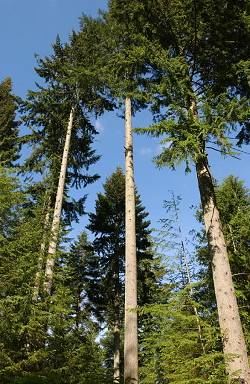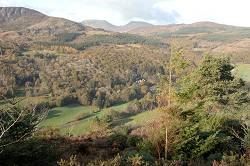Summary
Key findings
 Low impact silvicultural systems such as continuous cover forestry will help to maintain shade and shelter within woodland habitats. High quality timber from productive woodlands, such as this Douglas-fir in Gwydyr forest, can be achieved by selecting species well suited to sites and climatic conditions in future decades.
Low impact silvicultural systems such as continuous cover forestry will help to maintain shade and shelter within woodland habitats. High quality timber from productive woodlands, such as this Douglas-fir in Gwydyr forest, can be achieved by selecting species well suited to sites and climatic conditions in future decades.
- The expected warmer climate will improve tree growth nationally. Productivity will generally increase, by up to 2 to 4 cubic metres per hectare per year (m3 ha-1 yr-1) for conifers on sites where water and nutrients are not limiting.
- The climate of central and eastern Wales is likely to remain favourable for growing broadleaved species capable of yielding high-quality timber.
- Except under the high-emissions scenario later this century, oak and ash suitability will remain high providing some security for robust native woodland habitats in Wales.
- The species assemblages of woodland communities are likely to change.
- Changes in the seasonal distribution of rainfall will cause more frequent summer drought and more frequent winter flooding.
- Changes in the frequency of extreme winds may cause more wind damage.
- Pest and disease ecology will change with the climate; for example, more frequent green spruce aphid attacks may reduce Sitka spruce growth in west, east and south Wales.
Emerging recommendations
- Low-impact silvicultural systems (LISS) and the use of mixtures are likely to provide the basis for secure adaptation strategies.
- Where other management regimes are used, a wider range of species and genetic material within a species will increase stand resilience in a changing climate.
- Acceptance of natural colonisation of some non-native but naturalised tree species (e.g. beech) in woodlands may be a valid adaptation strategy, but this must be reviewed where conservation is a major objective.
- Contingency plans need to provide an adequate response to the potential increase in occurrence of catastrophic wind damage, fire, and pest or disease outbreaks.
 A ‘no-regrets’ policy should seek to incorporate more species in stands and woodland blocks, to spread the risk of climate change impacts, and reduce the likelihood of severe damage to woodland habitat. Suitable provenances of native species have a role to play in climate change adaptation management.
A ‘no-regrets’ policy should seek to incorporate more species in stands and woodland blocks, to spread the risk of climate change impacts, and reduce the likelihood of severe damage to woodland habitat. Suitable provenances of native species have a role to play in climate change adaptation management.
